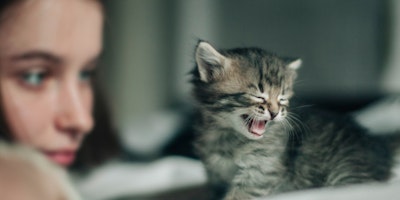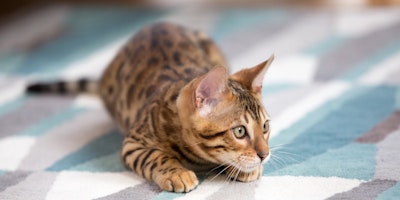
As any cat owner can tell you, cats can be mysterious and mercurial companions. While cats can be great at communicating when they want to, there are plenty of times that cats leave their owners completely stumped. Despite their occasionally confusing behavior, cats, like most poker players, often have a tell: their tails.
Cat Tail Communication
Along with purring, meowing, direct eye contact or an arched back, cat tail movement can often indicate how a cat is feeling, their mood, and their intentions. So, what does it mean when a cat wags their tail or, perhaps more accurately, swishes it back and forth?
While cats will continue to stump their owners, answering this question can help you understand your cat and build a stronger bond between you.
Cat Tail Moods
Let’s look at some common cat tail movements and positions and explore what they mean. That way, you’ll have a better idea when your cat feels playful, agitated, confident, worried or any other mood that will cause them to send out signals with their tails.
Cat Tail Movements & Positions
Question mark: When a cat bends its tail in the shape of a question mark, this is good news, especially if you have a few minutes to spare and some cat toys at the ready. That’s because the question mark-shaped tail position is a cat’s way of asking you, “would you like to play?” Cats may also move the tip of their tails back and forth with the question mark changing orientations, which is an even more intense play signal.
Pointing straight up: If a cat walks into the room, tail sticking straight up, they’re feeling confident, comfortable and ready to engage in some friendly interaction. This tail position indicates all is right in the world—or at least it is from the cat’s perspective. Furthermore, a tail that points up accompanied with a quiver at the base of the tail is often an indication your cat is especially excited to see you or to be getting a tasty bowl of cat food.
Tail wrapping: Have you ever seen a cat wrap their tail around another cat or maybe even a person? If you interpreted that as a sign of friendship and affection, you’re correct. Be sure to reciprocate with a friendly scratch and some words of praise.
Tucked-away tail: When a cat tucks their tail under their body or wraps it around themselves, this can be a sign of uncertainty that may indicate feelings of fear and submission. This is especially true when this tail position is accompanied with wide eyes, dilated pupils and flattened ears. Remember, however, context is important.
For example, a cat sitting on your lap may curl their tail around themselves for warmth or because it’s just a comfortable thing to do. In that context, you don’t need to worry. But if a cat seems standoffish and tense, check to see if something nearby or something you’re doing is causing them fear or alarm. In the meantime, let the cat have their space.
Back-and-forth swaying tail: You’ve probably noticed your cat’s tail do this when they’re intensely focused on something like a toy, and might be about to pounce. This tail movement does, in fact, mean a cat is in the zone and has zeroed all their attention on a target of interest but is likely feeling playful. The same is not true if they’re thrashing their tail back and forth, however.
Back-and-forth thrashing tail: Unlike a slowly swaying tail, when your cat thrashes their tail back and forth, you’ve got an annoyed and/or angry cat on your hands and it may be about to become aggressive. See if something nearby is upsetting them. If so, remove it from the situation. Meanwhile, it’s best to give your cat a wide berth until it calms down.
Puffed-up tail: When a cat puffs up their tail, be on alert. This is a clear message that they are aroused or afraid. The puffed-up tail is common around other animals and might be intended to make them seem larger against a potential attacker. If you notice your cat behave this way towards other animals or people outside of the context of play, make sure to separate them if you can do so safely.
As you can see, the movements of a cat's tail have meaning and many of them are easy to interpret. Remember to interpret these tail movements in the context of your cat’s other body language signals and the current situation, however. The more you become aware of your cat's body language, the better you will be at knowing how they're feeling, allowing you to act accordingly and best provide for your cat's emotional needs.
There’s a lot more to learn about dog and cat behavior and a wide variety of other topics. Visit our Pet Expertise page and get valuable insights from our Pet Experts.
Related articles


Earn myPurina Rewards with Every Purchase
Use your points for treats, toys, and gift cards with myPurina app.


